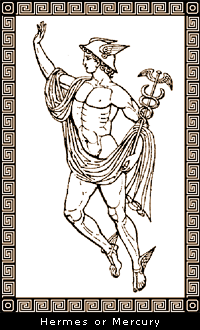GREEK MYTHOLOGY
HERMES
And His Magic Wand
 Hermes, the messenger god on Mount Olympus, had a magic wand called a Caduceus, which was given to him by Apollo. The Caduceus is a rod or staff framed by two intertwined snakes; at the top of the staff are two wings.
Hermes, the messenger god on Mount Olympus, had a magic wand called a Caduceus, which was given to him by Apollo. The Caduceus is a rod or staff framed by two intertwined snakes; at the top of the staff are two wings.
The Caduceus symbolizes the spinal column, the central conduit for the Psychic Force, or nerve energy, which animates all the organs and members of the body. The places where the snakes cross represent the spinal energy centers or chakras of the subtle body.
The two snakes represent the two complementary halves of the nervous system: motor and sensory, sympathetic and parasympathetic. For optimal functioning of the nervous system, these complementary halves must be balanced.
Hermes, also called Mercury by the Romans, is sometimes pictured as a hermaphrodite, or a person who is half male and half female. So it is with the nervous system; it is neither emissive/masculine/Yang, nor is it receptive/feminine/Yin, because it incorporates both principles, or polarities.
The essence of the nervous system is communication, and Hermes, or Mercury, is the god of communication, transportation, and commerce. Greek mythology also depicts Hermes as a clever trickster, sent out on missions by Zeus and other Olympian gods to do their dirty work. And so, Hermes symbolizes the Mercurial adaptability of the mind, which must survive by living by its wits and ingenuity.
Esoterically speaking, the two intertwining snakes of the Caduceus symbolize the lunar Ida and solar Pingala channels of yogic philosophy, which must be cleared and balanced in order for the kundalini energy, or serpent power, to ascend from the base of the spine to the crown, producing enlightenment. In the Western esoteric tradition, this is called the Alchemical Marriage.
Snakes also have a profound symbolic significance in science, medicine and healing. The snake, which periodically molts, or sheds its skin, is a symbol of healing, regeneration and renewal. In ancient Greece snakes, which move about without any visible means of support or locomotion, were considered to be the wisest and cleverest of all animals.
Asclepius' staff has only one snake entwined around it, which symbolizes healing, regeneration, and the consummate skill of the medical art. Hermes' Caduceus has two intertwined snakes, which, in addition to all the above, also represent the need for balance, or homeostasis, for optimum health maintenance and disease prevention.
It seems as if snakes were also solar symbols. Apollo, who gave the Caduceus to Hermes, is often pictured with snakes. And the staff of Asclepius, son of Apollo, has a snake entwined around it. The sun, as the source of all Life and energy in our universe, is deeply connected with healing and the expression of vitality and wellbeing in general.
Acknowledgements:
Cassell's Dictionary of Classical Mythology by Jenny March
Entry on Hermes - pg. 389
















